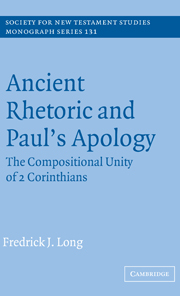Book contents
- Frontmatter
- Contents
- List of figures
- List of tables
- Preface
- List of abbreviations
- 1 An apology for the unity of 2 Corinthians
- Part 1 A survey of ancient forensic discourse
- 2 The anatomy of a genre: sources, nature, and features of forensic rhetoric
- 3 Forensic exigency
- 4 Forensic invention
- 5 Forensic disposition
- 6 Apologetic letters
- Part 2 A rhetorical analysis of 2 Corinthians as ancient apology
- Appendix I How the peroratio (12.11–13.10) summarizes 2 Corinthians
- Appendix II Topoi for each subtype of the qualitative stasis
- List of references
- Index of biblical references
- Index of ancient authors and sources
- Subject index
6 - Apologetic letters
Published online by Cambridge University Press: 12 November 2009
- Frontmatter
- Contents
- List of figures
- List of tables
- Preface
- List of abbreviations
- 1 An apology for the unity of 2 Corinthians
- Part 1 A survey of ancient forensic discourse
- 2 The anatomy of a genre: sources, nature, and features of forensic rhetoric
- 3 Forensic exigency
- 4 Forensic invention
- 5 Forensic disposition
- 6 Apologetic letters
- Part 2 A rhetorical analysis of 2 Corinthians as ancient apology
- Appendix I How the peroratio (12.11–13.10) summarizes 2 Corinthians
- Appendix II Topoi for each subtype of the qualitative stasis
- List of references
- Index of biblical references
- Index of ancient authors and sources
- Subject index
Summary
Introduction: the problem of Paul's letters and epistolary speeches
Many interpreters, such as Jan Lambrecht (1989), Dennis L. Stamps (1992, 1995; cf. 1999), Classen (1992), Jeffrey T. Reed (1993), Stanley E. Porter (1997a, 1997b, 1999), Anderson (1996, 1999), and Philip H. Kern (1998), question the applicability of ancient rhetoric to Paul's epistles and typically favor modern universal rhetoric or discourse theory (cf. Black, 1989, 1990).
These interpreters have raised many significant questions and arguments. First, Paul did not use rhetorical terminology in the technical senses that truly corresponded to rhetorical meanings (Anderson, 1996, pp. 122–23, 253–55 contra Fairweather, 1994; cf. Black, 1990, pp. 63–64, who questions Betz, 1985). Second, the choice of rhetorical species for individual letters is difficult to determine and therefore unhelpful, since scholarly opinions conflict (e.g., for Galatians see Kern, 1998, pp. 120–66). Third, a foreign structure is imposed on the letters with considerable variation from one rhetorical critic to the next (Porter, 1997b, pp. 539–61; Kern, 1998, pp. 90–119). Fourth, Paul's letters do not correspond to the appropriate venue associated with the respective species, e.g., the courtroom or assembly (Kern, 1998, pp. 16, 18, 29–33, 204–208). Fifth, the rhetorical handbooks are used almost exclusively as a basis for analysis of Paul's letters, when in fact, there were other rhetorics circulating, such as philosophical rhetoric, epistolary rhetoric, diatribe, synagogue homily, and common conversation (Kern, 1998, pp. 12–30; cf. Winter, 1997, p. 240). Sixth, the existence of an “apologetic letter” genre is questioned (Kern, 1998, p. 33; cf. Hansen, 1989, pp. 25–27).
- Type
- Chapter
- Information
- Ancient Rhetoric and Paul's ApologyThe Compositional Unity of 2 Corinthians, pp. 97 - 114Publisher: Cambridge University PressPrint publication year: 2004

